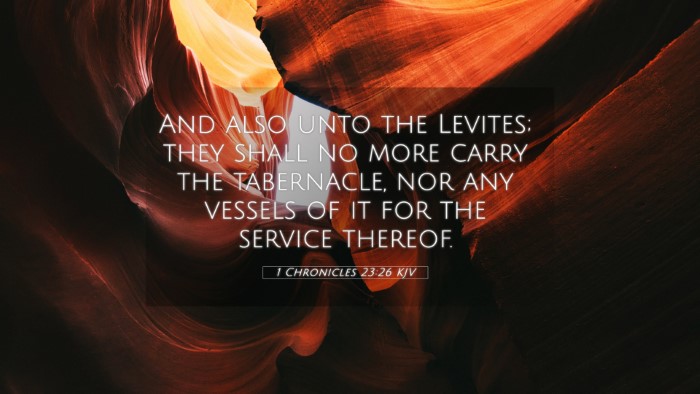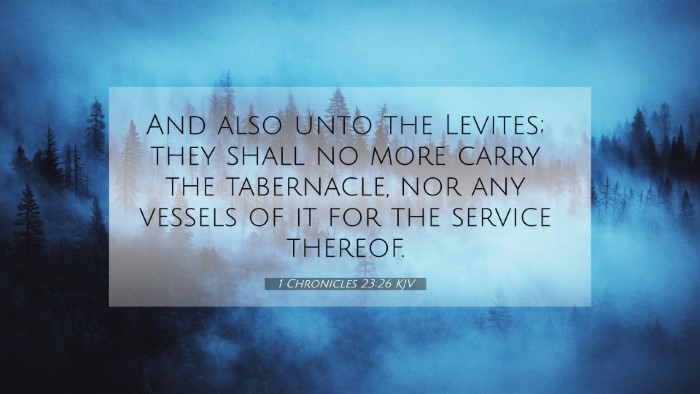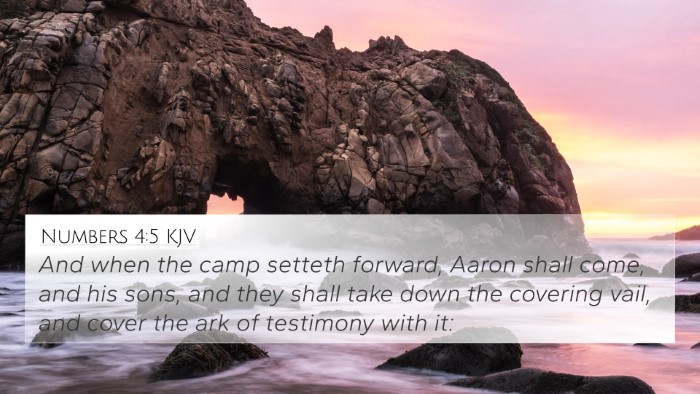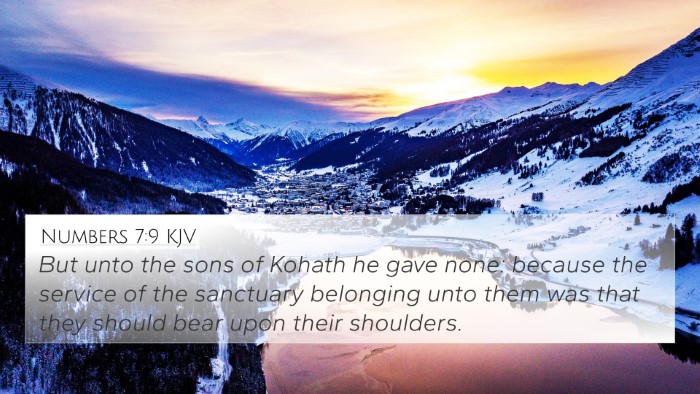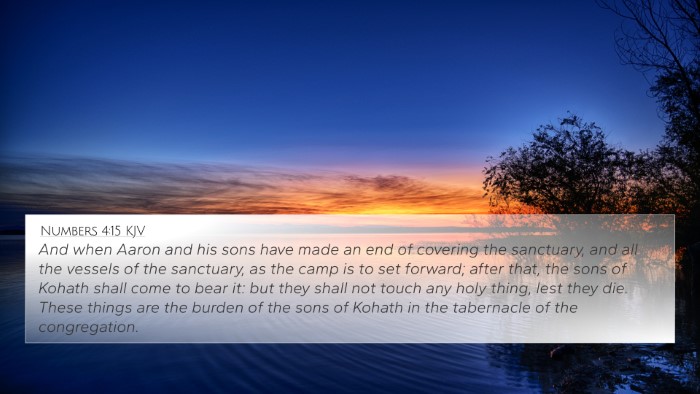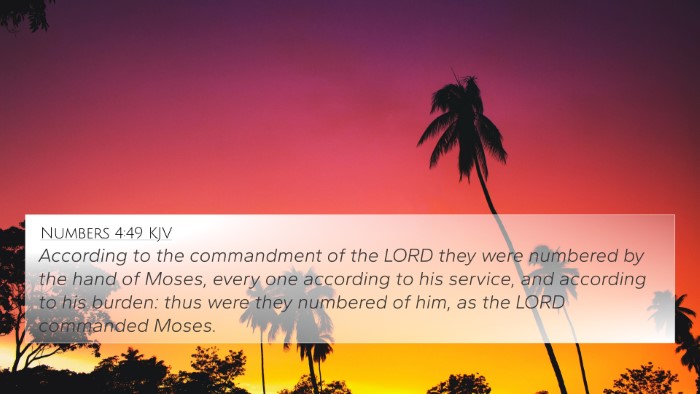Understanding 1 Chronicles 23:26
Verse: 1 Chronicles 23:26 - "And said to them, 'You shall no longer carry the tabernacle, or any of the articles for its service.'"
Summary of Meaning
The verse in 1 Chronicles 23:26 marks a significant transition in the duties of the Levites concerning the tabernacle. It signifies the end of the mobile worship system that characterized the Israelites during their wilderness wanderings and emphasizes a new phase in God's worship as the nation settles in the Promised Land. The cessation of carrying the tabernacle symbolizes stability and permanence in worship.
Commentary Insights
-
Matthew Henry's Commentary:
Henry elucidates that this directive to cease transporting the tabernacle reflects God's intention to establish a fixed place for worship. This would enhance the sanctity and reverence for the worship of God, as a stationary location allows for a dedicated space for priestly activities. He notes that this verse illustrates God’s providence in determining how and where He will be worshipped.
-
Albert Barnes' Commentary:
Barnes emphasizes the administrative change among the Levites. The transition signifies that the Levitical duties would become more structured and focused on worship and service in a centralized location, rather than the previous nomadic practice. Barnes points out the importance of this stability for the spiritual life of the Israelites and the assurance it provides in their worship practices.
-
Adam Clarke's Commentary:
Clarke discusses the implications of this directive as a preparation for the future temple worship. He notes that the cessation of transporting the tabernacle was a precursor to the eventual establishment of the temple, which would serve as a permanent dwelling for the presence of God among His people. Clarke highlights how this change reflects the progress of God's plan for worship through Israel.
Cross-References
This verse has several inter-Biblical parallels that enhance its understanding:
- Exodus 25:8 - "And let them make Me a sanctuary, that I may dwell among them." This establishes the idea of God wanting a permanent place for His presence.
- 1 Kings 8:13 - "I have surely built You an exalted house, and a place for You to dwell in forever." This reflects the fulfillment of the transition to a permanent worship space.
- Deuteronomy 12:5-6 - "But you shall seek the place where the LORD your God chooses, out of all your tribes, to put His name for His dwelling... and there you shall bring your burnt offerings and your sacrifices." This emphasizes the centralization of worship.
- Jeremiah 7:12 - "But go now to My place which was in Shiloh, where I set My name at the first." This speaks to the importance of designated places of worship.
- Hebrews 9:2 - "For a tabernacle was prepared, the first in which was the lampstand, the table, and the showbread, which is called the sanctuary." This mentions the tabernacle's significance in the worship system.
- Psalm 132:5 - "Until I find a place for the LORD, a dwelling for the Mighty One of Jacob." This reflects the search for a permanent dwelling for God’s presence.
- Acts 7:44 - "Our fathers had the tabernacle of witness in the wilderness..." This acknowledges the historical significance of the tabernacle before the establishment of the temple.
Connections and Thematic Insights
This verse, while seemingly straightforward, opens up rich thematic discussions and connections within the Bible:
-
The Theme of God's Presence:
The move from a mobile tabernacle to a permanent temple illustrates God’s desire to dwell among His people, aligning with themes found in John 1:14, "And the Word became flesh and dwelt among us."
-
Transition in Worship Practices:
Understanding how worship transitioned from a nomadic form to more structured helps contextualize New Testament worship activities, as discussed in 1 Corinthians 3:16 regarding believers being God's temple.
-
Historical Context of the Levitical Order:
The organizational aspect of the Levites not carrying the tabernacle anymore sets the stage for understanding their roles in temple worship, which are expanded upon throughout the Pentateuch and historical books.
Tools for Bible Cross-Referencing
Utilizing various tools for cross-referencing can deepen the understanding of how verses and themes are interconnected:
- Bible concordance - A key tool for finding specific words or phrases and their occurrences throughout the Bible.
- Bible cross-reference guide - Provides lists of related scriptures that offer insights into specific themes.
- Cross-reference Bible study methods - Various techniques to study how verses relate to each other thematically and contextually.
Conclusion
In conclusion, 1 Chronicles 23:26 encapsulates the significant transition in Israel's worship practices, signaling a move towards permanence and structure in relation to God’s presence among His people. Through a careful study of this verse and its connections to broader biblical themes, believers can gain a deeper appreciation for God's design for worship and how it progresses throughout the Scriptures.

